HTML image code collection
HTML image code includes g> tag, border attribute, attribute, style attribute, d attribute and style attribute.

HTML is one of the most basic languages in web design, and pictures are one of the essential elements in web design. Below is a complete collection of image code HTML codes for your reference.
1. Insert the picture
g> tag. The syntax is as follows:
src="图片文件路径" alt="图片描述" width="宽度" height="
The height src attribute is used to specify the file path of the image; the alt attribute is used to specify the description text of the image. When the image cannot be loaded, the text will be displayed; the width and height attributes are used to specify the image. The width and height can not be set.
2. Set the picture border
To set the picture border, you can use the HTML border attribute. The syntax is as follows:
src="图片文件路径" alt="图片描述" border="
Border width The border attribute is used to specify the width of the border, in pixels.
src="图片文件路径" alt="图片描述
3. Set the image alignment
attribute. The syntax is as follows:
="对齐方式
ter etc.
4. Set the image style
To set the style of the image, you can use the style attribute of HTML. The syntax is as follows:
src="图片文件路径" alt="图片描述" style="
Style attribute: value; the style attribute is used to specify the style attribute and value, for example:
src="图片文件路径" alt="图片描述" style="border:1px solid red;
5. Set the picture background
dattribute. The syntax is as follows:
d="图片文件路径
d attribute is used to specify the file path of the background image.
6. Set the image size
To set the size of the image, you can use the style attribute of HTML. The syntax is as follows:
src="图片文件路径" alt="图片描述" style="
width: width; height: height; style attribute is used to specify the values of width and height. If only one of the properties is set, the other property will be automatically adjusted according to the proportions of the image.
The above is a complete collection of image code HTML codes, I hope it will be helpful to everyone.
The above is the detailed content of HTML image code collection. For more information, please follow other related articles on the PHP Chinese website!

Hot AI Tools

Undresser.AI Undress
AI-powered app for creating realistic nude photos

AI Clothes Remover
Online AI tool for removing clothes from photos.

Undress AI Tool
Undress images for free

Clothoff.io
AI clothes remover

Video Face Swap
Swap faces in any video effortlessly with our completely free AI face swap tool!

Hot Article

Hot Tools

Notepad++7.3.1
Easy-to-use and free code editor

SublimeText3 Chinese version
Chinese version, very easy to use

Zend Studio 13.0.1
Powerful PHP integrated development environment

Dreamweaver CS6
Visual web development tools

SublimeText3 Mac version
God-level code editing software (SublimeText3)

Hot Topics
 1386
1386
 52
52
 Table Border in HTML
Sep 04, 2024 pm 04:49 PM
Table Border in HTML
Sep 04, 2024 pm 04:49 PM
Guide to Table Border in HTML. Here we discuss multiple ways for defining table-border with examples of the Table Border in HTML.
 HTML margin-left
Sep 04, 2024 pm 04:48 PM
HTML margin-left
Sep 04, 2024 pm 04:48 PM
Guide to HTML margin-left. Here we discuss a brief overview on HTML margin-left and its Examples along with its Code Implementation.
 Nested Table in HTML
Sep 04, 2024 pm 04:49 PM
Nested Table in HTML
Sep 04, 2024 pm 04:49 PM
This is a guide to Nested Table in HTML. Here we discuss how to create a table within the table along with the respective examples.
 HTML Table Layout
Sep 04, 2024 pm 04:54 PM
HTML Table Layout
Sep 04, 2024 pm 04:54 PM
Guide to HTML Table Layout. Here we discuss the Values of HTML Table Layout along with the examples and outputs n detail.
 HTML Input Placeholder
Sep 04, 2024 pm 04:54 PM
HTML Input Placeholder
Sep 04, 2024 pm 04:54 PM
Guide to HTML Input Placeholder. Here we discuss the Examples of HTML Input Placeholder along with the codes and outputs.
 HTML Ordered List
Sep 04, 2024 pm 04:43 PM
HTML Ordered List
Sep 04, 2024 pm 04:43 PM
Guide to the HTML Ordered List. Here we also discuss introduction of HTML Ordered list and types along with their example respectively
 Moving Text in HTML
Sep 04, 2024 pm 04:45 PM
Moving Text in HTML
Sep 04, 2024 pm 04:45 PM
Guide to Moving Text in HTML. Here we discuss an introduction, how marquee tag work with syntax and examples to implement.
 HTML onclick Button
Sep 04, 2024 pm 04:49 PM
HTML onclick Button
Sep 04, 2024 pm 04:49 PM
Guide to HTML onclick Button. Here we discuss their introduction, working, examples and onclick Event in various events respectively.



